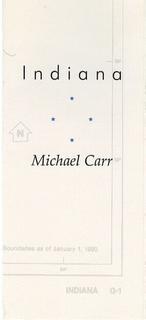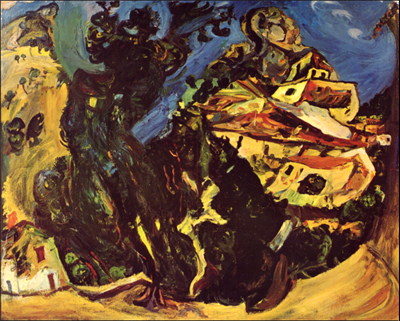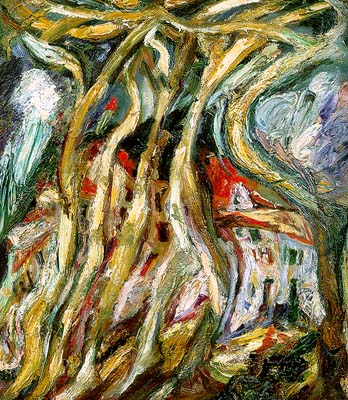Chris Rizzo on Anchorite Press
 How long has Anchorite Press been in existence? And could you speak about the history of Anchorite and how the Press has evolved into its present state?
How long has Anchorite Press been in existence? And could you speak about the history of Anchorite and how the Press has evolved into its present state?I started the press in 2003. At first, I took on small projects, such as broadsides. With each project, I better developed my understanding of both design and production. For example, Michael Carr’s tri-fold pamphlet Indiana was the logical precursor to Geof Huth’s tri-fold pamphlet forkèd lake. Conceptually, I knew what I’d wanted to do with Indiana, but pragmatically I hadn’t any hands-on experience, so to speak. Thus, when Geof sent me his ms., I had a much better understanding of what one could do with the tri-fold form. The same holds true for chapbooks.
This said, I’ve also tried to develop the press by way of studying the publications produced by other small presses. What fonts are used and how are they used? What size is the book? What papers are used and how are they used? How is the book bound? How do the design elements relate to one another and to the given text? What are the ramifications? And so on. I tend to ask questions of artifice to not only learn about the particular book in my hands, so to speak, but in general terms to learn as much as I can about the art of printing as well.
How many titles has Anchorite Press published?
Over the past few years Anchorite has done single sheet broadsides, folded broadsides, pamphlets and chapbooks. (I consider a pamphlet to be a much smaller, less ambitious project than a chapbook.) I do have publication lists, but there are just too many to mention here. In fact, I’d be hard pressed to remember all of them off the top of my head.
How does Anchorite Press chose its projects?
Good question. Anchorite publishes the work of young poets who, generally speaking, have very few publications to speak of; I’ve made a couple of exceptions in the past, but that’s the fundamental guiding principle. Because the press is limited in scope, I usually solicit material, but, again, I’ve made exceptions to this rule.
After hearing Noah Eli Gordon read his long poem “What Ever Belongs In The Circle,” I asked him for a copy, gave the poem a read, and then asked him if he’d like to do a chapbook. The current Anchorite project underway is a chapbook entitled The Parrot Bride by Theo Hummer. After receiving a query letter from Theo, I read the ms. and decided to take on the project. So, I find poetry to publish and poetry to publish finds me; although, as I said earlier, I usually solicit material.
Do you select your projects based on what you consider to be your, "company of poets", i.e. poets who you feel some sort of kinship with based on their work, or is the selection done according to a different sense of community?
I usually select linguistically challenging poetry to publish. Anchorite did develop out of a “company of poets” in and around the Boston area, but I have tried to expand the horizons of the press a bit. Having recently relocated to Albany, I hope the press will at some point begin to reflect the community of artists and thinkers in the area. In other words, at this point in time Anchorite publishes young poets, but this may not always be the case.
How do you fund Anchorite Press?
My wallet. And donations. Anchorite isn’t big enough, in my opinion, to list as a non-profit and, therefore, funding resources are limited. When I began the press, I used what’s commonly referred to as “disposable income” to put out new publications. The costs aren’t overwhelming, though. Chapbooks are the most expensive ventures, of course, but due to the fact that I do all the work in house—designing, typesetting, printing, folding, cutting, and binding—I can produce the books in a relatively inexpensive way. Such a handmade manner of production has shaped the look and feel of Anchorite publications.
Anchorite Press seems to keep a somewhat low profile, in terms of distribution and publicity, not esteem, can you speak to why you’ve decided to use this approach to publishing?
Out of necessity. As I’d mentioned earlier, each project is done by hand, which saves money, but costs me quite a bit of my own time. To date, I’ve yet to find a proverbial partner in crime to take over some of the existing press responsibilities. If I had more time, I’d publicize more often. By and large I leave PR duties to the poets themselves.
Anchorite Press seems perhaps more DIY than any other press I know of, you have a hand in every part of the process, beyond financial considerations, why have you chosen this approach?
Simply put? Megalomania!
In all seriousness though, this question ties directly into your previous question. I enjoy the process of bookmaking, especially on such a small scale, where each book in a run is given individual attention. The press began as a one man show, so to speak, and I’ve tried to do as much as one person can do with a small press. Friends have helped along the way with design considerations, production, readings for new publications, etc., which leaves me tremendously grateful. As I’d mentioned before, I’m open to the idea of partnership, but that simply hasn’t happened yet.
You have spoken about approaching Anchorite Press more as a record label than a publishing house, could you explain the difference and why this different model?
This is a tough question. When I first began to discover small press publications, I likened them to both independent music and film. In other words, the art made a way into the world via a small budget and, for lack of a better phrase, creative ingenuity, not to mention both the willpower and the desire to “get the work out there” as Creeley might have said. Anchorite Press is a tiny establishment; in other words, when I say that the work is done “in house,” I mean my house, which so far as I can see is analogous to recording a band in either a garage or a basement studio.
My other thoughts on the subject are far more problematic. Suffice it to say, however, that to view the press as an independent record label rather than a publishing house deflates any sense of literary officialdom that hangs over the head of the business of books. To put it simply, I hope to circumvent traditional publishing venues that embrace the phrase “publishing house,” for in the main such venues need to embrace consumer culture as well.
Anchorite seems to publish avant/newer poetry while maintaining a considered historically conscious design. Could you speak about the relationship between small press publishing and writing past and present and how you envision Anchorite’s role in all of this?
Well, I can speak directly to the last part of your question, viz., Anchorite’s relationship to small presswork and historically conscious design. I first became interested in publishing after learning a bit about the history of the book. There were several texts that caught my interest, especially The Coming of the Book by Lucien Febvre and Henri-Jean Martin. Anatomy of a Typeface, A Book of the Book, Texts on Type, and The Elements of Typographic Style are all texts that immediately come to mind as well. Through reading, I’ve learned much about how books—both generally and particularly speaking—have come into being. So far as I can see, to look at an historical model, such as a Scolar’s facsimile of Pope’s An Essay on Man, is just as instructive as the study of Gerrit Lansing’s A February Sheaf, published by Pressed Wafer in 2003. I analyze the design and break it down into fundamental elements, elements which may or may not prove useful to me as a designer in the future. I touched on this subject earlier, when I spoke of how Anchorite evolved into its present state.
Are there other small presses or magazines whose work you find worthy of mention?
More than I could mention here, for certain. The amount of terrific small press and magazine work that’s being done today is overwhelming. To answer your question specifically, though, I’d need to know what you mean by “small.” In other words, there are small presses and then there are small presses, Anchorite being among the latter of the two. Examples of the former would be Green Integer, Sun & Moon, or The Figures. One new small press that has impressed me very much is Katalanché, edited by Michael Carr and Dorothea Lasky. They’ve not only produced good looking chapbooks, but have done magazine type ventures as well, such as American Weddings.
What do you envision for the future of Anchorite Press?
I envision more of the same in the immediate future. I hope that Anchorite will be able to expand and eventually file for non-profit status, begin using ISBN numbers, etc. That takes dedication by more than one person, as I’d suggested earlier. At the moment, there are chapbooks to print, upon which I’m focused. Who knows, really, what in the future will happen.















